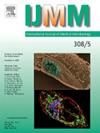Enteropathogenic Escherichia coli revisited – New insights into old EPEC isolates using whole genome sequencing
IF 3.6
3区 医学
Q1 MICROBIOLOGY
引用次数: 0
Abstract
Enteropathogenic E. coli (EPEC) cause severe diarrhoeal disease in children under the age of three in low- and middle-income countries. Upon ingestion of contaminated food or water, the bacteria colonise the small intestine. EPEC are grouped into typical and atypical isolates based on the presence or absence of the genes encoding the bundle-forming pilus (Bfp), with tEPEC (Bfp+) adhering to cells in microcolonies, whereas aEPEC show a more diffuse adherence phenotype. All EPEC express a type III secretion system (T3SS) encoded on the locus of enterocyte effacement (LEE) pathogenicity island, which is required for the translocation of effector proteins into the host cell, aiding bacterial adhesion and survival. Historically classified as EPEC by serogroups according to WHO guidelines, current practice identifies EPEC by PCR for characteristic virulence genes eae (intimin) and bfp. Here, we analysed a collection of 41 older clinical isolates initially grouped as EPEC using whole genome sequencing (WGS) combined with phenotypic characterisation including biofilm formation, adherence type, and pedestal formation. This allowed us to correctly define isolate pathotypes in addition to determining the integration site of the LEE and identifying three potential new T3SS effectors. Uniting phenotypic characterisation with genetic information, we were able to identify the molecular mediators of observed phenotypes. This suggests that, while non-WGS-based isolate profiling is important to decide immediate treatment options, only detailed knowledge of the isolates can provide in-depth information on the potential disease development and severity.
重新审视肠致病性大肠杆菌-使用全基因组测序对旧EPEC分离株的新见解
致病性大肠杆菌(EPEC)在低收入和中等收入国家的三岁以下儿童中引起严重的腹泻病。一旦摄入受污染的食物或水,细菌就会在小肠内繁殖。根据编码束状菌毛(Bfp)基因的存在与否,EPEC被分为典型和非典型分离株,tEPEC (Bfp+)在微菌落中粘附细胞,而aEPEC表现出更分散的粘附表型。所有的EPEC都表达一个编码于肠细胞吞噬(LEE)致病性岛位点的III型分泌系统(T3SS),这是效应蛋白易位到宿主细胞,帮助细菌粘附和生存所必需的。根据世卫组织指南,历史上按血清组划分为EPEC,目前的做法是通过PCR检测特征毒力基因eae(内膜素)和bfp来确定EPEC。在这里,我们分析了41个早期临床分离株,最初使用全基因组测序(WGS)结合表型特征(包括生物膜形成、粘附类型和基座形成)分组为EPEC。这使得我们除了确定LEE的整合位点和识别三种潜在的新的T3SS效应物外,还能正确地定义分离的病理类型。将表型特征与遗传信息结合起来,我们能够识别观察到的表型的分子介质。这表明,尽管非基于wgs的分离株分析对于决定即时治疗方案很重要,但只有对分离株的详细了解才能提供有关潜在疾病发展和严重程度的深入信息。
本文章由计算机程序翻译,如有差异,请以英文原文为准。
求助全文
约1分钟内获得全文
求助全文
来源期刊
CiteScore
9.70
自引率
0.00%
发文量
18
审稿时长
45 days
期刊介绍:
Pathogen genome sequencing projects have provided a wealth of data that need to be set in context to pathogenicity and the outcome of infections. In addition, the interplay between a pathogen and its host cell has become increasingly important to understand and interfere with diseases caused by microbial pathogens. IJMM meets these needs by focussing on genome and proteome analyses, studies dealing with the molecular mechanisms of pathogenicity and the evolution of pathogenic agents, the interactions between pathogens and host cells ("cellular microbiology"), and molecular epidemiology. To help the reader keeping up with the rapidly evolving new findings in the field of medical microbiology, IJMM publishes original articles, case studies and topical, state-of-the-art mini-reviews in a well balanced fashion. All articles are strictly peer-reviewed. Important topics are reinforced by 2 special issues per year dedicated to a particular theme. Finally, at irregular intervals, current opinions on recent or future developments in medical microbiology are presented in an editorial section.

 求助内容:
求助内容: 应助结果提醒方式:
应助结果提醒方式:


